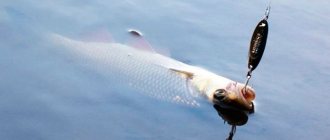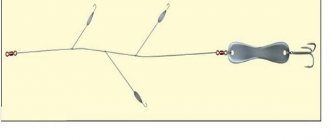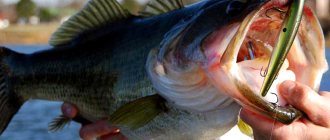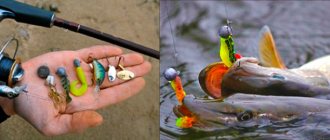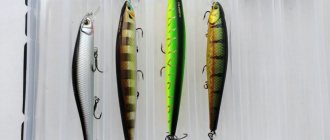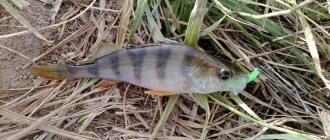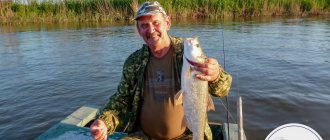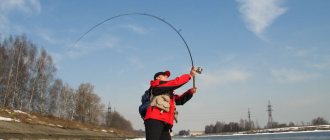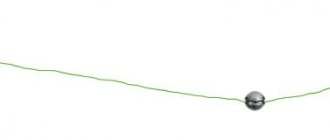Is it possible to fake a castmaster?
By trying to accurately counterfeit this bait with commercial intent, the “pirates” are wasting their time. They make a completely different lure, with different performance characteristics. After all, similarity does not mean catchability, since when making a fake, the main idea that is inherent in the castmaster is lost - to depict a small fish hit by a predator on the surface, falling very naturally to the bottom.
For this purpose, Art LaValle came up with not only a geometrically accurate shape of the bait, not only its center of gravity was precisely selected, but also a special metal alloy of a certain density was developed, which made it possible to make a fall-gliding in the water column in such a way that it is impossible for a “double” to repeat. Other baits of a similar shape immediately fall into a tailspin and are mainly suitable for near-surface high-speed retrieval when catching asp. These products can also set records for casting distance.
How to choose a castmaster for pike?
Despite the apparent similarity of castmasters, certain models are used for different pike fishing conditions. Models with tees are used for fishing in areas with a clean bottom. If there are snags or a lot of grass at the bottom, then instead of a standard tee, install a non-snacking tee.
If there is no such tee, then the antennae can be made from thin steel wire. This is easily done using small pliers. In other cases, they are caught using lures with a single hook.
To catch pike in quiet waters and at short distances, it is better to use bright models. They stand out among other objects and vegetation. The wires are usually short and unhurried, so priority is given to lighter or medium-heavy models weighing up to 15-20 grams, but with red threads or a silicone skirt attached. Castmasters have approximately this format:
If we talk about the most common castmasters for pike fishing, then this is the classic silver model. It is clearly visible even in muddy water and in general very much resembles a fry swimming in the water column. Slightly less popular are spinners with a golden color. There are also multi-colored castmasters.
When fishing with castmasters, you can follow the usual rule: in bright weather and in clear water, use duller and darker models, and when fishing in cloudy weather and from the shade of coastal trees, use bright and shiny spoons.
How to distinguish a real castmaster from a fake
I don’t think that Chinese craftsmen will ever fake a castmaster to zero. In addition, the Chinese never set out to copy anything exactly. But spinning anglers who want to not only cast bait far, but also hold the fish they catch in their hands, must be able to distinguish a fake from an original when purchasing.
Winding rings. The main and simplest difference between a real castmaster and a fake is the winding rings, which are cut obliquely and inward. In fakes, they are bitten off perpendicular to the turns of the wire. To make a custom-made winding ring, you need a special, expensive cutting machine. Moreover, the cutting line of the original itself is very smooth, without burrs.
The hooks of fakes are always blunt and often shiny, while the hooks of the original are matte, well sharpened, with a special coating for salt water.
Printing house. Counterfeits always have sloppy packaging and crooked typographical inscriptions. The plastic on the packaging of a fake is almost always wrinkled around the perimeter and glued crookedly.
Dimensions. In addition, for obvious reasons, counterfeiters do not make baits for castmaster in small and very small sizes - this is simply impossible to do in artisanal conditions. And in the best case, you will find a “Chinese” on sale weighing about 14 g, but never less than 7 g.
Quality of surface treatment. If you compare the original and the fake, it’s immediately clear what I’m talking about. A real bait's surfaces are not only coated with shiny galvanization, but also perfectly polished.
And the simplest advice on how to buy the original is to purchase baits only in specialized stores where the entire line of castmasters is on sale - from 2.5 g and above.
Making castmaster spinners with your own hands
Many skilled fishermen want to save on the purchase of baits and make catchy working copies in artisanal conditions. The Kastmaster spinner is no exception.
Manufacturing methods
- Sawing down a metal rod.
- Metal casting.
- Casting in plaster mold.
For this method you will need: a vice, a metal rod and a hacksaw (or grinder). The rod is taken with a diameter of 10 - 20 millimeters, but you can choose a different diameter. It all depends on your preferences. The material of the rod can be different - iron, aluminum, copper, stainless steel.
However, remember that the bait will come into contact with water, and therefore ordinary iron will quickly rust. Aluminum and copper are susceptible to oxidation, so stainless steel is a good option because it does not corrode and has a metallic sheen.
We fix the rod in a vice and cut off the excess parts at an acute angle. Then we dull the sharp edges with a file so as not to cut ourselves and not to cut the fishing line in the future. We clean the treated surfaces with sandpaper.
After rough operations we polish our product. Along the edges of our spoon, holes are drilled for winding rings to attach the bait to the fishing line and attach the tee. The Kastmaster spinner is ready!
Metal casting
For this method you will need a metal tube. The material of the workpiece is basically not important. The shape is sawn off at sharp angles, which the spinner will acquire in the future. The difficulty is that the form must fit tightly to the surface on which the pouring will take place. After you have placed the form on the surface, start pouring.
Lead or tin are suitable for this. They have a good weight and are easy to handle. After pouring, the metal form is carefully sawed. If after pouring there are uneven surfaces and edges, file them. Then holes for the winding rings are also drilled, and the spoon itself is cleaned with sandpaper and polished (or painted).
Casting in plaster mold
The advantage of this method is that it is much easier to make the mold, because plaster is easier to process. The shape of the future spinner is “cut out” in plaster. This must be done carefully, since gypsum is a fragile material.
The inner surface where the material will be poured should be so smooth that after you break the mold, a minimum of irregularities remain on the surface of the spoon.
This will simplify the final finishing of the bait in the future. Once the mold is ready, start pouring. Lead or tin are also suitable for this. After pouring, the mold is broken, the edges and surfaces of the part are smoothed with a file, sandpaper, and holes are drilled along the edges.
Some subtleties and required wiring speed
Often, many anglers position this spoon as the main “specialist” for catching asp. Mostly riding and most often gregarious. That is, these anglers are not using the most valuable vertical component in the bait game.
But in this article I don’t want to consider the rather primitive fishing for an apex school predator using kastmasters - in this fishing, in my opinion, there are only two simple tasks. The first is to silently approach the place where the fish are fighting, the second is to cast the bait as far as possible. In this type of fishing, anyone can be a successful fisherman - both a master and a beginner, and almost any bait is suitable here - Chinese pieces of iron “castmaster” and homemade “cuts” from a metal rod, and even a simple nut with a tee tied to a cord!
But when catching passive fish from the bottom at medium and great depths, these same “some subtleties” arise when it is necessary to use both the vertical vector of the bait and the horizontal during one retrieve.
The first phase of retrieving is understandable - it is the same for almost all deep-sea lures: cast, close the bow, taking out the slack in the line, and wait for the spoon to fall to the bottom. The most difficult part comes next - how to properly animate the bait already lying on the bottom, and then catch the necessary rhythm of movement when retrieving. In addition, all phases of wiring have their own subtleties.
For example, such a point as speed, which is important when fishing with all types of baits, often comes to the fore when using a castmaster.
It happens that fish attack the bait only at the minimum speed of the retrieve, and you need to catch exactly that pace, which is necessary and often the only correct one, so that when retrieved, the spoon “rests” on the water, and does not fall through or go sideways. Only a slow speed in many situations will help provoke a passive predator to bite.
The question often arises: how to start retrieving a bait lying motionless on the bottom? Turning the reel handle? Short or long hooking with a spinning rod? And the length of the pause is also important. It happens that 2 seconds pass and the fish doesn’t bite. And you pause for 4-5 seconds, and immediately see a positive result.
What allows you to catch pike with a castmaster?
There are several properties of cut spinners that make it possible to successfully catch pike with a castmaster.
Firstly, this is the weight of the bait. Any castmaster spinner, be it a product from Acme or a craft from Chinese cooperatives, is very heavy for its geometry. In fact, it is a round or multifaceted metal rod, sawn off at different angles.
Thanks to the weight of the spoon, it can fish at any depth. The low lifting force that occurs with such a specific gravity relative to the area of the bait allows you to drive the castmaster to such a depth where no other lures will work.
That is, you can, of course, lower Kuusamo Professor and Williams Wabbler to a depth of 15 meters, but the sailing “tail” of a braided cord of such a length (casting length + wiring depth) will pull them to the surface. And this is at any, in fact, wiring speed.
The castmaster will walk calmly and steadily at a depth of 15-20 meters with a slow stepwise retrieve, scratching along the bottom and provoking the pike to bite.
Guiding a castmaster through deep places almost always gives interesting results.
Also, the weight of the bait allows you to cast over the longest distances. For pike fishing from a boat, this is not so important; we are not catching asps.
But for catching pike from the shore this is very important. Sometimes only 5-8 meters are not enough to reach the riverbed edge or the irrigation mounds. Unlike jigs or spinners, the castmaster does not sail at all. That's why it flies as far as possible.
The weight of the bait is 28 grams or 36 grams, allowing you to throw it with a spinning rod of 3.30 by 120 meters and further on a thin braided cord with a Teflon sheath.
Secondly, this is the shape of the bait. It allows you to reel at any depth, speeding up or slowing down the reeling with a spinning reel. This means that you can catch pike with a castmaster at any depth, simply by choosing the line faster or slower.
You can drive the bait to depth, you can bring the castmaster at a depth to the exit of the hole or to the riverbed dump. Then, slightly speeding up the wiring, begin to lift the castmaster above the bottom and drag it onto the obstacle. And if there is a snag or a flooded tree in the path of the bait, pull the bait and move the castmaster at an accelerated pace, preventing it from hitting a blind hook.
Choosing a spinning rod for a castmaster
This is a very subtle point. Firstly, I’ll say right away that there should be several spinning rods, covering the entire line of baits with their tests. Because often only small-sized castmasters catch passive fish, while heavier ones do not. And for light bait you need a spinning rod with a certain test. For bait of the next weight, you also need your own spinning rod, and so on, depending on the depth of fishing and the speed of the current.
Let’s assume that the main topography of the reservoir where we are fishing is underwater mounds, ravines or vast plateaus next to the riverbed—feeding outlets for schools of pike-perch, bersh and perch, and the traditional “jig” weights that are used in these places are 10-14g. According to my feelings, regarding the upper limit of the test of the rod, for such conditions I take a spinning rod 7.0-8.0 feet long with a test of 12-14 g for baits, if I use a 14-gram castmaster for fishing, and a test for a cord of 6- 10 lbs.
If fishing is carried out at shallow depths or the perch is at half-water, I use bait weighing 7 g or less, and an appropriate spinning rod. A fast action spinning rod with a thin flexible tip is best suited for a castmaster. Working in the upper range of the spinning rod allows you to better feel the play of the bait - most of the top of the blank is bent under load, and due to this, the separation of the bait from the bottom is smooth, and the phase of falling and “fluttering” in the water column turns out to be continuous, visually close to falling to the bottom stunned fish.
That is, when the forward thrust stops (during the falling phase of the bait), the tip of the spinning rod does not stop working, fully straightening in one second, but is constantly under load, which allows you to be in constant contact with the bait, and clearly works in time with the bait, tracking it work. After all, fish are often caught precisely during the falling phase, and the loaded tip of the spinning rod helps to reliably detect it. To put it simply, the tip of the spinning rod at this moment plays the role of a nod and a kind of hooker. That is why it is important to accurately select the weight of the bait for the depth - here, as with jig fishing, it is not possible to use heavy baits at small and medium depths - the castmaster must hover in the water column for as long as required in a given place, and its weight must be optimal (and often - minimal) for a specific bottom landscape.
In addition, very often, if not always, a passive perch needs the bait to have clear contact with the ground. The perch approaches the gliding castmaster, but does not dare to attack it. The “dying fish” lies motionless on the bottom, but then suddenly comes to life in a brazen manner and tries to escape. The perch is no longer able to withstand this behavior of the prey and attacks the bait. If a spinning angler uses too coarse tackle for fishing, then it will not be possible to “catch” the desired contact with the ground.
Weight scale and colors
The range of castmaster scales is quite wide and can satisfy both ultralight and heavy jig lovers. As for the color range, it is quite diverse, but officially now the baits supplied to Russia are mainly of the following colors:
silver; golden; silver with holographic sticker; silver with blue stripe; silver with red stripe. Experts from the Moscow company that supplies Acme baits rightly believe that this color line is quite enough to fish in our country.
Selection of bait size
It is known that a well-fed perch is more likely to catch very small baits. But amazing things often happen to active bass. It happens that these fish attack castmasters only of a certain size. And this size has nothing to do with the size of the “feed” fish. For example, you catch a perch, from whose mouth a small smelt, bleak or other fry literally falls out. Place a castmaster of the same length as the food object, but there are no bites. There is not even an attempt to chase the bait. But as soon as you put the castmaster a size or two larger, without changing anything else, the perches begin to be caught one after another. Apparently, this is connected with the very essence of the behavior of the “striped robber”, who strives to get ahead of his pack neighbors and grab a larger and fatter victim. It is with this greed that I associate the often encountered in practice catching two perches at once with one wobbler.
Castmaster for perch
If the perch is well-fed, in most cases it reacts and is caught by small baits. But active perch often attacks baits of various sizes and without any limiting frames. For example, if while fishing you notice a given predator with a small bleak in its mouth, you should not think that the perch will only react to bait of this size.
You can put on a small castmaster and not see a single bite, but if you attach a little more bait, active predators will begin to be caught one after another. This behavior of the perch is most likely due to its nature and thirst to catch larger prey than other “relatives”.
Fishing in still water
There are many options for wiring a castmaster. But I identify four main phases for myself. And most often, “my” passive fish can be forced to rush to the bait by the sequential use of all four phases in the order in which I describe them.
Wiring method No. 1 Fall phase - “vertical”. This is the most wonderful phase, the most valuable thing is how a castmaster knows how to fall and plan. It is the falling wounded fry that is most often picked up by cautious large predators a little away from the bustle of the perch. And most often - at the very bottom or at the moment when the bait has already fallen to the ground and the cord begins to sag. This is a very important point; you must be ready to respond to a bite in time with a hook. Pulling phase. If predators do not dare to bite, but are clearly in the splashdown zone of the bait, I usually do this. Before starting to lift the spoon, I drag it along the bottom. The spoon lies on the bottom. Having straightened the cord and slightly extended the tip of the spinning rod towards the spinner, I begin, slightly playing and tugging (as if lifting the head of a stricken fry above the ground), slowly dragging the castmaster along the bottom. The length of such “pulling with twitching” can be different: from 5 cm to 30-40. The bait, raising a cloud of turbidity, swaying and glistening on its sides, often causes a bite from perch and pike perch. If fishing conditions and equipment allow, this “crawl away” of the wounded fry from the predator can be diversified by fine trembling of the spoon: drag the bait along the bottom, and make frequent short vertical movements with your hand, as when fishing in winter from ice with a jig. Such “aggressive” behavior of the prey often ends with a powerful bite from an angry predator. The take-off phase of the spinner is the “step”. You can tear the spoon off the bottom in two ways: by turning the reel or tossing it with a spinning rod. It is necessary to decide which method to use, and experimentally find out which wiring and at what height is preferable at this moment (when throwing and jerking with a spinning rod, the upper part of the trajectory graph is higher, sharper than when manipulating the reel), and often changing the beginning of the wiring leads to that other fish are starting to be caught, both in species composition and in size. How to start retrieving depends on whether you are fishing in current or still water. In addition, you need to clearly understand how much cord the reel winds in one revolution, that is, how fast it is. This depends on both the gear ratio of the reel and the size of the spool. But I almost always prefer to tear the lure off the bottom with a jerk of the rod of the required amplitude and speed. The phase of rewinding a slack cord. I have already said that often the spoon must move in the water at the minimum possible speed so that during the reeling phase the three forces influencing it are balanced: the vector of the “forward thrust” force, the vector of the “gravity of the earth” and the buoyant force of the water. The fish, which did not dare to attack the “dying fry” in the previous phases, rush to the bait, irritated by the agility of the suddenly “revived victim”.
Monotonous serving options
This includes several wiring options, each of which will attract the attention of a predator. Winding the warp onto the reel evenly and at the same speed after casting is most suitable for catching asp. The bait is offered and held exactly where the predator is; a quick presentation will help create an imitation of a fry running away from its pursuer.
For catching pike, a slow, even feed is more suitable; it is best used in closed reservoirs without a current. In this case, the Castmaster will perform zigzag swings in the horizontal plane with a small amplitude.
Wave-shaped wiring is suitable for both standing water and rivers. Before retrieving, throw the spoon into the desired place, then wait until it completely sinks to the bottom or is in the desired thickness. Next, make several rotations with acceleration, during which the bait moves upward diagonally. The pause following this will allow it to slowly descend to the desired level. Only an experienced fisherman who also knows the reservoir well can do everything correctly.
Simplified wiring method - “American”
The fishing method described above can be significantly simplified (especially when you are dealing with active fish and fishing speed is important) by narrowing it down to two phases. The first is that the rod “looks” at the bait lying on the bottom. Then a fairly energetic upward jerk is made with the spinning rod. In this case, the spinning rod takes a vertical position. At this time, the bait first makes a jump from the bottom to the length of the rod’s swing. The line sags, the bait floats to the bottom. The second - the slack in the fishing line is removed, and the second “step” begins.
The described “American” wiring (we can call it conventionally “bottom jerking”) is perfect for ordinary jig baits, and in general for all baits that can be “put” on the bottom fairly quickly, i.e. fast-sinking (heavy rattlins, oscillating spoons, spinners with a front weight). Jerking the bait often provokes an indecisive predator to attack, and such wiring near the bottom is even more so.
Fishing with a jig "step"
The castmaster can also be used as a jig bait, making quick movements with the reel handle that are already familiar to many spinning anglers while the spinning rod is completely stationary. Yes, such wiring is very primitive in nature. But it is also very effective; in many cases it can be the initial, basic wiring for all types of deep baits. For many fishermen, it is best to start mastering castmaster with jig wiring. And only then, increasing or decreasing the speed, the length of the line, changing the weight of the bait, you will have the correct connection, the feeling of a castmaster under water, you will learn to understand your actions. The main thing is not to rush, but to constantly train and not wait for immediate results. Indeed, in any sport, and in fishing too, the number of repetitions of any exercise is proportional to the skill of its use.
Fishing in a strong current - Fishing with drift
Fishing on the river allows you to use a castmaster in the same way as a spinner when fishing from the shore, from a boat or by wading - for demolition. We throw a bait of suitable weight under the other bank and, adjusting the process with the spinning-line angle, we fish different horizons. The castmaster, supported by a stream of water, moves in a smooth arc. In the place where the influence of the current weakens (usually at the boundary of the stream and the water), the bait will begin to sink and “catch” the entire thickness of the water. By the way, it is often in such places that fish stand, waiting for food to be washed away here by the current. Naturally, we select the weight of the bait according to the depth, speed of the river and the thickness of the cord, so that the bait does not get stuck at the bottom, but goes a little higher.
With each new cast, you should increase the flight range of the bait, gradually examining the entire accessible sector of the river. In the river area where the bites have started or the first fish has already been caught, you can try to reduce the weight of the bait or switch to other types of baits, replacing the “scout” from the “platoon” of castmasters with a more specialized specialist - a soldier from the “platoon” of wobblers, for example.
Method No. 2 Almost completely repeats the “American” method described above, but the current makes its own adjustments, keeping the bait “afloat”, the fall is much longer. You can diversify the wiring by performing swings not only along one line - straight down as follows. Having tilted the spinning rod to the extreme left (or right) position, the spinner stands facing down the river and, bringing it as close as possible to the water, jerks the rod upward at an angle of 45 degrees. If you do this in still water, you will simply get a straight line in one plane along the line “splashdown point - tip of the spinning rod.” And in a strong current, you will get a very wide arc with a complex trajectory, with horizontal sections of the path during sweeps and “steps” “unfolded” in the vertical plane while falling to the bottom.
When fishing in still water, the bait moves almost in one line, or rather, in one plane. When fishing in a strong current, already at the jerk stage, the bait moves in an arc, being knocked down by the current. And at the second stage - the stage of the castmaster falling to the bottom, it is very strongly carried down by the current from the point of separation to a new point of fall to the bottom, and a “flight” trajectory is obtained. The fishing sector using this method on the current is several times larger than when fishing in a straight line.
This technique allows you to fish “micro-reliefs” away from straight-line fishing, without leaving the same place and, accordingly, without creating unnecessary noise when moving. In addition, fish controlling the upper horizon will respond better to the first part of the retrieve, and bottom fish will respond better to the rest of the retrieve.
Tactics and fishing techniques
To begin with, it is worth noting that when fishing from the shore, the maximum effectiveness of the bait is revealed only when using the right gear. When fishing from the shore, a rod should preferably be 2.4-2.7 m, allowing for power casting over long distances. When fishing from a boat, a length of 1.8–2.1 m will be sufficient. Medium and hard spinning rods are best suited. It is better to use an inertia-free reel. There is no consensus on the equipment of the reel.
Some anglers use monofilament line or use braided line. As mentioned above, fishermen remove the winding rings from the bait because when using rings, swivels or carabiners, instead of a high-quality game, the spoon begins to “float” on one side. Because of this, the attractiveness to predators is lost. It is recommended to tie the lure to the main fishing line or cord in advance.
It is best to do this with a figure-eight knot; however, when using this method, the effect of “burning out” the line at the knot occurs, which is why you can lose both the treasured trophy and your favorite bait.
To avoid this, the lure for pike and other predatory fish is equipped with a tungsten leash, which is secured close to the bait with a loop-to-loop knot. A swivel is tied to the other end of the leash in the same way, and the length of the leash is 20-30 cm.
The tactics for catching a Kastmaster spinner are varied, depending on the place where you are fishing. The Kastmaster spinner can be fished throughout the entire reservoir, which is often done by spinners who want to quickly find fish that are actively hunting, as well as in local areas where predators live.
If you fish a large area, then the stability of the game, streamlined shape and weight will help you with this. Since, thanks to its streamlined shape, this bait flies much further than its competitors and does not sail, as does, for example, a “spinner” or a jig bait. You can try to look for a predator in the water column, at a depth of 3-5 m. Or try to look at the bottom. Everything will depend on the weather and pressure.
Fishing local spots brings more chances of a good catch. In summer, these are snagged areas, the boundaries of water and aquatic vegetation, or near fallen trees and beaver dams.
Main wiring
The main wiring of the Kastmaster spinner is to evenly twist the fishing line onto the reel spool (uniform wiring). This should be done neither quickly nor slowly. At the border of the spoon “falling” to the bottom. Take small pauses that will imitate a sick, tired fish falling to the bottom.
Often it is during such pauses that the bite occurs. You can also experiment with the depth of the drive, the frequency of pauses and jerks. Sometimes even the most unexpected decisions bring great results.
Wiring with a vertical component
Fishermen often use fishing rods with a vertical component. Undoubtedly, this is winter fishing, as well as “jigging” wiring (or in other words, stepped fishing). The essence of these postings does not change - the bait lies on the bottom, then two or three turns are made with the reel to tear the bait off the bottom. Then the bait, having traveled some distance in the water column, again sinks to the bottom. This fishing method is effective when the fish is lying on the bottom, as well as when there are a minimum of hooks on the bottom of the reservoir.
Also in the summer, the “winter” method of fishing is used. The fisherman either swims up to a snag or sunken tree and begins to gently “knock” the bait on the bottom. Due to its “cut” shape, the Kastmaster spoon does not fall vertically to the bottom, but makes complex movements in the water column, tempting a predator.
These lines are good at catching all types of predatory fish. But let's sort it anyway:
- Uniform wiring - mainly pike, as it waits for its prey in hiding. Less commonly, perch, asp.
- Step (jigging) - pike perch, pike and occasionally perch. Pike perch, as a rule, is caught on rivers and sticks to a rocky bottom, and on rivers it is best to catch with a jig bait.
- Vertical fishing (winter version) - perch, less often - pike.
"Fluttering" fishing
This method appeared in my practice relatively recently and has shown its complete consistency and effectiveness. It consists of the following. It doesn’t matter how the boat is oriented or whether the fishing is wading - such wiring can be carried out along the drop-off, edge and when guiding from shallows to depth, and vice versa. I throw the bait down - diagonally, over the river bed or other longitudinal depressions, choosing the weight so that it “feels” the bottom with great difficulty. And I begin to make a stepped, wide wiring against the current towards myself - obliquely.
When the castmaster hits a sharp drop in the river, into a hole, stops feeling the bottom and is carried away by the current, you should open the reel arm or switch it to reverse. In the first case, the floating of the bait downstream is controlled by holding the cord between the fingers (everything is exactly the same as when fishing with a wobbler “from yourself”. In the second case, the spool of the reel rotates, and I brake it with my hand. Braking is necessary so that the bait does not tumble , but floated in the water column, near the bottom, on its own plane on a stretched cord, actively playing at the same time, and its speed was less than the speed of the flow. Only in this case will the castmaster maintain his original game. For such a swim of the bait along the drop down Not only fish standing in the same horizon, but also bottom predators often respond to the current by biting. It was this type of fishing that allowed me to catch several small catfish on the ripples near Astrakhan using a castmaster.
Features of pike fishing on Kastmaster
This bait is not recommended for use where there is a lot of snags and algae on the bottom, because the hooks often cling to what is in the water and there is a high risk of the gear breaking. Castmaster spinners for pike are good in the following places:
- deep holes,
- channel section,
- long ditches,
- edges, rifts and deep slopes.
Castmaster size for pike
When catching this predator, it is recommended to use several sizes of spoons, starting with a universal weight of 14 grams and a medium size. If the fish are not active, you can use a smaller bait, and if there is a chance of encountering a large pike, you will need a larger Kastmaster. You should not immediately use the smallest size spoon, as it may not interest large fish.
Wiring a castmaster for pike
Fishing with castmaster can be done in a variety of ways, such as:
- Uniform, unhurried - suitable for animation both in the headquarters and in a river with a strong current, both in the thickness of the reservoir and closer to its surface.
- Wave-shaped - used in the water column and in the coastal strip.
- Uneven is a method of provoking a sluggish predator to attack the bait, used in different conditions.
- Stepped – suitable for animation at depth, when hunting large individuals in any type of reservoir.
- Ryvkovaya, used mainly in the water column.
Why autumn is the best time to catch pike with castmaster
Before wintering, the predator accumulates nutrients, so it feeds especially actively. It is more mobile, so it can be found both in the water column and closer to the bottom. It is in this range that the castmaster works.
Video: Castmaster fishing for pike
Not exactly a practical master class, but the video gives a clear idea that pike can be caught perfectly with this bait.
The castmaster is a lure that different types of freshwater and sea predators cannot resist, especially when played skillfully. In our opinion, such a bait should be in the arsenal of any spinning rod and winter angler.
Views: 2,417
Surface jerk wiring
Somehow, purely mechanically, I started fishing with a castmaster. Moreover, in a fairly shallow body of water, it was with jerk wiring that I immediately caught it! Until this moment, none of the predators attacked either the wobbler or the spinner. To be honest, I don’t have enough statistics on such fishing yet, but it’s definitely worth trying to fish this way with a castmaster. It is also necessary to try such near-surface jerking on large bodies of water, adjusting the duration of the pause to local conditions.
Combined equipment
I am not a supporter of using combined equipment. I like to feel even the slightest touch of the fish on the bait. Therefore, I like it when a single bait is tied to the end of the cord, no matter what - a wobbler or a spinner, and the connection “bait - my hands” is as rigid, direct and sensitive as possible. But sometimes you have to give up principles - the fish have become too capricious - and knit all sorts of combinations. One of these simplest combinations is a tandem of castmaster and twister (or wabik, streamer), tied a little higher. This combination allows:
clearly monitor the bottom, because the fish are still tied to the relief; The castmaster, with its play, glitter and noise, attracts even the most aggressive and hungry fish from afar, “collecting” them in the wiring area on the castmaster even large predators are caught, and on the upper small twister - all the fish in a row, starting with small perches; allows you to quickly identify the preferences of fish at the moment and, if necessary, quickly adjust. I always place the castmaster on a soft leader made of multi-strand metal material. The leash, 15-20 cm long, is equipped with a swivel at the top, and a carabiner clasp at the bottom for quickly changing the bait. Directly to the upper swivel, on another, but small clasp or on the winding ring, I attach a second, smaller bait - a twister on a double or single, a wabik or a streamer. Of course, with such a workload, the castmaster somewhat loses his original game, but nevertheless he still catches fish perfectly. True, it often happens that the pike wants to try the top bait, cutting off the castmaster too.
Additional "decorations"
Often in the literature you can see in the photo a castmaster equipped at the back, for example, with an offset hook with a twister. Such equipment should help when fishing in supposedly dense snags. But it should be noted that when fishing in deep snags, only surface baits do not cling to underwater branches at all, and the best of them, undoubtedly, are poppers and rubber frogs. You have to understand well that with such equipment, the precisely selected balancing of the castmaster is instantly lost - and instead of swaying and fluttering when diving to the bottom, we see a fast-sinking bait diving to the bottom with its tail - twister up. This combination bait can be used very effectively when fishing with a slow, almost straight-line retrieve, without long pauses - dives. In this case, this tandem has no equal in terms of flight range (and, accordingly, fishing area) and almost does not cling to uneven surfaces on the bottom.
How to play as a castmaster
Kastmaster is a unique spinner. You need to play it carefully, measuredly, but at the same time, without falling asleep on the go. Many people prefer this element because it is universal. If you do the wiring correctly, and sometimes they can be done at different speeds, then the predator will definitely pay attention to the movements, deciding to ask what it is.
Considering the design of the spinner, the retrieves can be wavy, jerky, stepped or uniform. Which technique to use depends on the specific situation.
Taking into account the fact that the main target is the pike, the wiring should be carried out evenly and unhurriedly. Such fish will not appreciate fuss or harshness, so it is better not to experiment with this. If nothing works with the pike, then you should change the technique a little. In this case, it is worth trying a wave-like or stepwise technique.
Catching pike with a castmaster is simple and makes it possible to fish absolutely all horizons with just one spoon. This bait is effectively used on mountain streams and rivers, on reservoirs where there is a current and where there is no current, on large rivers. In a word - wherever you want.
Read how to catch a beginner with a spinner so that your fishing is as effective as possible.
Disadvantages of a castmaster
Of course, I am not satisfied with the hooks - maybe they are good for the sea, but they are not very suitable for my river fish - there are a lot of hooks. And often I replace the original hooks with Owner or Gamakatsu. I use different tee sizes for the same castmaster size - for catching perch I use a size smaller than the original, and when fishing for pike perch and pike - either the same ones, or I increase the size of the hooks. It is important that the weight of the hooks is approximately the same and does not change the balance of the spoon. Sometimes, if the fish is passive and only “bales” the bait without being caught, I fish with a castmaster with a homemade brush made of red woolen threads that cover the winding ring and tee.
Description of castmasters
The bait is available in five versions - 7, 14, 21, 28 and 35 g. The classic color is silver. The set consists of one winding ring and a treble hook. Any spinning rod with an optimal length of 2.5-2.7 meters is suitable for working with a castmaster. It is better to use a spinning reel; it is much more convenient for long-distance casting. Mono fishing line is more suitable for fishing with this bait, because it has a number of advantages:
- High elasticity.
- High abrasion resistance.
- Uniform laying on the reel.
- Performs well at low temperatures
Winding rings
I have one more small question for the manufacturer - why are some spinners supplied to Russia equipped with two winding rings (that is, one on the tee and the other in the front of the bait), and some without a ring at the beginning? What is this, the American economy? This causes great inconvenience - you have to look for rings of good quality and large diameter on sale and spend time on equipment. And without such a winding ring there will be no correct play of the spinner. Keep this in mind when purchasing a spinner - all castmasters must have a front winding ring! After all, if you attach a castmaster to the clasp of a leash without a winding ring, then when fishing for large fish (or sharp casting), the clasps often unfasten or unbend (because the castmaster presses with its edge on the wire of the narrow fastener). Both the fish and the bait are lost.
Vladimir Gerasimov

